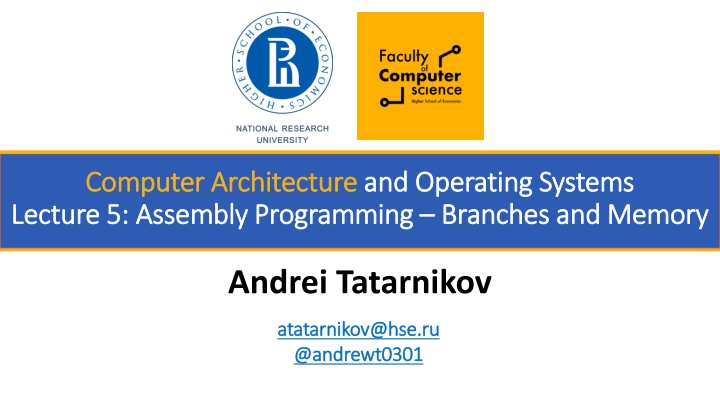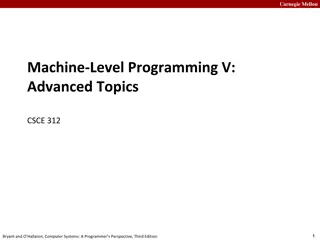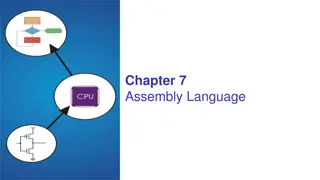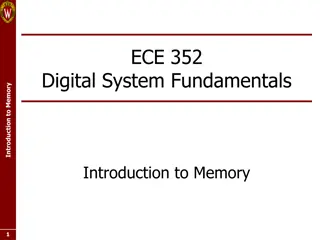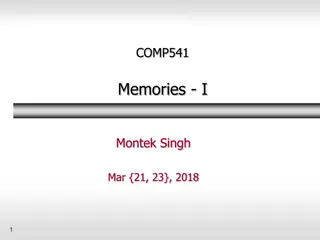Assembly Programming: Branches and Memory Layout
This lecture discusses assembly programming focusing on branches and memory layout. It covers topics such as program structure, addressing, program counter, branch instructions, and branch pseudo instructions. Learn about labels, control flow instructions, and more in computer architecture and operating systems.
Download Presentation

Please find below an Image/Link to download the presentation.
The content on the website is provided AS IS for your information and personal use only. It may not be sold, licensed, or shared on other websites without obtaining consent from the author.If you encounter any issues during the download, it is possible that the publisher has removed the file from their server.
You are allowed to download the files provided on this website for personal or commercial use, subject to the condition that they are used lawfully. All files are the property of their respective owners.
The content on the website is provided AS IS for your information and personal use only. It may not be sold, licensed, or shared on other websites without obtaining consent from the author.
E N D
Presentation Transcript
Computer Architecture Computer Architecture and Operating Systems Lecture Lecture 5 5: Assembly Programming : Assembly Programming Branches and Memory and Operating Systems Branches and Memory Andrei Tatarnikov atatarnikov@hse.ru atatarnikov@hse.ru @andrewt0301 @andrewt0301
Program Structure and Memory Layout Program Structure and Memory Layout 0x 7FFF EFFC Stack .data hello: .string "Hello, world!" Dynamic Data 0x1004 0000 .text .data main: 0x 1001 0000 li a7, 4 la a0, hello ecall .text 0x 0040 0000 Reserved 0x 0000 0000 2
Labels Labels Labels are symbolic names for addresses (in the .data or .text segment). Labels are used by control-flow instructions (branches and jumps). Labels are used by load and store instructions. 3
Addressing Addressing Addresses can be represented in several ways 4
Program Counter Program Counter Program Counter (PC) is a special register that stores the address of the currently executed instruction. When an instruction is executed, the PC is incremented by the size of the instruction (4 bytes) to point to the next instruction. Branch and jump instructions assign to the PC new addresses to change the control flow. Branch instructions use PC-relative addresses (increment or decrement current value by an offset). 5
Branch Instructions Branch Instructions Branch Instructions Branch = beq rs1, rs2, label Branch Branch < Branch Branch < Unsigned bltu rs1, rs2, label Branch Unsigned bgeu rs1, rs2, label bne rs1, rs2, label blt rs1, rs2, label bge rs1, rs2, label 6
Branch Pseudo Instructions Branch Pseudo Instructions Branch Pseudo Instructions Branch unconditionally j Branch = 0 Branch 0 Branch > Branch > Unsigned Branch > 0 Branch Branch Unsigned Branch 0 Branch < 0 Branch 0 label beqz rs1, label bgez rs1, label bgt rs1, rs2, label bgtu rs1, rs2, label bgtz rs1, label ble rs1, rs2, label bleu rs1, rs2, label blez rs1, label bltz rs1, label bnez rs1, label 7
Branches and Program Counter Branches and Program Counter Branch instructions are PC-relative They add a 12-bit signed immediate to PC The immediate is an offset from PC to the target label The branch address range is 212(4096 B = 4 KB) PC can be read with the auipc instruction main: auipc a0, 0 # a0 = PC + 0 li a7, 34 # Print as hex ecall # Print a0 8
Assembly Code for If Assembly Code for If- -Then Then- -Else Else if_0: bnez t0, if_less_0 li t1, 1 j end_if if_less_0: bgez t0, if_greater_10 li t1, 2 j end_if if_greater_10: li t3, 10 blt t0, t3, else li t1, 3 j end_if else: li t1, 4 end_if: if (t0 == 0) { t1 = 1; } else if (t0 < 0) { t1 = 2; } else if (t0 >= 10) { t1 = 3; } else { t1 = 4; } 9
Assembly Code for While Assembly Code for While while: li ecall mv beqz a0, end_while li a7, 1 ecall li a7, 11 li a0, '\n' ecall j while end_while: a7, 5 t0, a0 while((t0 = read_int()) != 0) { print_int(t0) print_char('\n') } 10
Assembly Code for For Assembly Code for For for: li ecall mv t1, a0 mv t0, zero next: beq t0, t1, end_for mv a0, t0 li a7, 1 ecall li a7, 11 li a0, '\n' ecall addi t0, t0, 1 j next end_for: a7, 5 for (t0 = 0; t0 < t1; ++t0) { print_int(t0) print_char('\n') } 11
Assembly Code for Nested For Assembly Code for Nested For mv t0, zero next_t0: beq t0, s0, end_for_t0 mv t1, zero next_t1: beq t1, s1, end_for_t1 print_int(t0) print_char(':') print_int(t1) print_char(' ') addi t1, t1, 1 j next_t1 end_for_t1: print_char('\n') addi t0, t0, 1 j next_t0 end_for_t0: for (t0 = 0; t0 < s0; ++t0) { for (t1 = 0; t0 < s1; ++t1) { print_int(t0) print_char(':') print_int(t1) print_int(' ') } print_char('\n') } 12
Macros Macros Macro is a pattern-matching and replacement facility that provides a simple mechanism to name a frequently used sequence of instructions. .macro print_int (%x) li a7, 1 mv a0, %x ecall .end_macro Use Macros to Simplify Your Code main: read_int(t0) print_int(t0) .macro read_int (%x) li a7, 5 ecall mv %x, a0 .end_macro 13
Including Macro Libraries Including Macro Libraries It is possible to place macros in a library file and include it in other assembly programs. .include "macrolib.s" main: read_int(t0) print_int(t0) The read_int and print_int macros are defined in the macrolib.s file. The file must be in the same directory as the program. 14
Macro Constants and Single Macro Constants and Single- -Line Macros Line Macros The .eqv directive can be used to define macro constants and single-line macros. .eqv VAL 0x123 .eqv X t0 .eqv Y t1 .eqv SUM addi Y, X, VAL main: li X, 0x111 SUM 15
Data Segment Data Segment Segment .data stores static data (global variables and constants), which are described with the following directives: .data .word 0xDEADBEEF .half 0x1234, 0x4567 .byte 0x98, 0x76, 0x65, 0x43 # 8-bit values .space 8 .ascii "Hello " .asciz "World! " # 32-bit value # 16-bit values # 8 bytes of empty space # String # Zero-terminated string 16
Data Alignment Data Alignment Data items are aligned in memory by their size for convenience of access. This means address is multiple of size. Default alignment is as follows: .byte # 1 byte .half # 2 bytes .word # 4 bytes It is possible to specify a custom alignment by 2n bytes for a next data item with the .align directive. .align 0 # 1 byte .align 1 # 2 bytes .align 2 # 4 bytes .align 3 # 8 bytes etc. 17
Data Alignment Example Data Alignment Example .data .space 3 word1: .word 0x12345678 half1: .half 0x1234 byte1: .byte 0x12 .align 4 word2: .word 0x12345678 .align 3 half2: .half 0x1234 .align 3 byte2: .byte 0x12 .align 0 word3: .word 0x12345678 Default Alignment Custom Alignment 18
Load and Store Instructions Load and Store Instructions Load Instructions lb t1, offset(t2) # t1 <- sign-extended 8-bit value from address t2 + offset lbu t1, offset(t2) # t1 <- zero-extended 8-bit value from address t2 + offset lh t1, offset(t2) # t1 <- sign-extended 16-bit value from address t2 + offset lhu t1, offset(t2) # t1 <- zero-extended 16-bit value from address t2 + offset lw t1, offset(t2) # t1 <- contents of address t2 + offset Store Instructions sb t1, offset(t2) # Store low-order 8 bits (byte) of t1 to address t2 + offset sh t1, offset(t2) # Store low-order 16 bits (half) of t1 to address t2 + offset sw t1, offset(t2) # Store contents of t1 to address t2 + offset Load Address Pseudo Instruction la t2, label # t1 <- address of label 19
Load and Store Example Load and Store Example .data x: .word 0 y: .word 0 # x, y, and z are static variables z: .word 0 .text main: int x, y, z; x = read_int(); y = read_int(); z = x + y; read_int(t0) la t2, x sw t0, 0(t2) read_int(t0) la t2, y sw t0, 0(t2) la t2, x lw t0, 0(t2) la t2, y lw t1, 0(t2) add t3, t0, t1 la t2, z sw t3, 0(t2) 20
Load and Store With Offset Example Load and Store With Offset Example .data # data[3] is a static array that stores three integer variables data: .word 0, 0, 0 .text main: la t2, data read_int(t0) sw t0, 0(t2) int data[3]; # x, y, z x = read_int(); y = read_int(); z = x + y; read_int(t0) sw t0, 4(t2) lw t0, 0(t2) lw t1, 4(t2) add t3, t0, t1 sw t3, 8(t2) 21
Load and Store Load and Store Pseudoinstruction Pseudoinstruction Example Example .data x: .word 0 # x, y, and z are static variables y: .word 0 z: .word 0 .text int x, y, z; x = read_int(); y = read_int(); z = x + y; main: read_int(t0) sw t0, x, t2 read_int(t0) sw t0, y, t2 lw t0, x lw t1, y add t3, t0, t1 sw t3, z, t2 22
Load and Store Pseudo Instructions Load and Store Pseudo Instructions Load Pseudo Instructions lw t1, (t2) # t1 <- contents of memory at address t2 lw t1, imm # t1 <- contents of memory address in imm lw t1, label # t1 <- contents of memory at label's address Store Pseudo Instructions sw t1,(t2) # Store t1 to address t2 sw t1, imm # Store t1 to address in imm sw t1, imm, t2 # Store t1 in to address in imm using t2 as temp sw t1, label, t2 # Store t1 to label's address using t2 as temp For instructions lb, lbu, lh, lhu, sb, and sh similar pseudo instructions are provided. 23
Any Questions? Any Questions? 24
